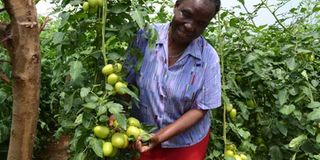With greenhouses, we’ve defeated erratic weather

Pauline Wafula in their greenhouse in Bungoma. PHOTO | ISAIAH ESIPISU | NATION MEDIA GROUP
What you need to know:
- The facility has enabled members of Silama Self-Help Group to grow crops without worrying about the adverse effects of climate change.
Pauline Wafula and Alice Omato from Sinoko village in Bungoma County tend to their tomatoes in a greenhouse on a chilly Monday morning.
It is warmer inside the greenhouse though, and the farmers are happy with the facility as they would not be worried of losing their crop due to the bad weather.
The greenhouse enables them to control the inside climate to suit their crops, instead of depending on the natural but ever shifting outside climatic conditions.
“The climate is changing very fast, and we must change the way we farm if at all we have to cope with such changes,” says Governor Ken Lusaka, whose office has distributed 105 greenhouses to farmers’ groups in the county in the past one year at a cost of Sh40 million.
Pauline and Alice, who are members of Silama Self-Help Group, are among the beneficiaries.
“Whether it rains or not, or whether the temperatures rise or drop, we will continue growing our crops without any problem,” says Alice, the treasurer of the group that has 18 members.
Bungoma County Government donated the facilities to registered farmers’ groups as start-up capital.
With technical support from agricultural experts and students from Egerton University, Silama group is now generating at least Sh90,000 per season of tomato after they sell the produce from the 24 by 8m greenhouse to traders in Bungoma.
The tomatoes take about two-and-a-half months to mature, according to the group’s treasurer. However, this also depends on the variety, and the care given to the crops.
“We use drip irrigation inside the greenhouse, making sure that each stem of tomato and other crops receive adequate water, and we ensure that there is enough manure.”
CONDITIONS HAVE SHIFTED
Bungoma has an average temperature of between 15 and 30 degrees Celsius with an annual rainfall of 1,500mm, which has always been suitable for agricultural production.
However, according to the farmers, the climatic conditions have shifted in the recent past, leading to either too much or very little rainfall in a given season.
“This has become a big challenge especially for climate-sensitive crops such as tomatoes,” says Pauline, the group’s chairlady.
By using greenhouses, the farmers have discovered that they can grow all sorts of crops at any time and take advantage of the market when there is low supply of such foodstuffs.
“Tomatoes have never performed well in this area during the rainy seasons. But with the greenhouse, we can control the inside environment and take advantage of the market during such seasons when tomatoes are scarce, usually between April and October,” says Wafula.
Experts say that certified greenhouse farming is the most-efficient use of land for producing fresh vegetables.
“Greenhouse farming uses less land, it is sustainable and water use is reduced. Few, if any, pesticides are applied and it can be used all-year round regardless of the climatic conditions,” says Isaac Amusabi, the agricultural extension officer in Bungoma South District.
The farmers have planted scallions (green onions) around their greenhouse, a technique that helps in keeping pests away.
“We have formed a greenhouse merry-go-round. This month, we are going to use the money earned from this particular greenhouse for the past three seasons to purchase a new structure for one member as we continue with the cycle until all of us end up with a greenhouse,” says the chairlady.
The group has invested in rainwater harvesting from roofs to support their farming.





